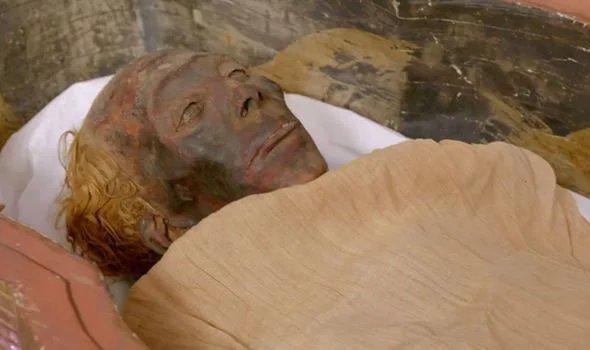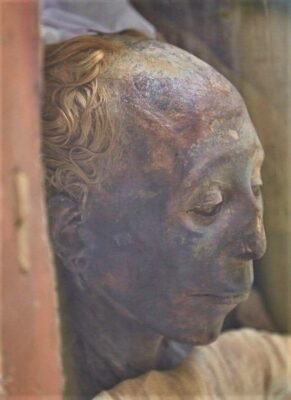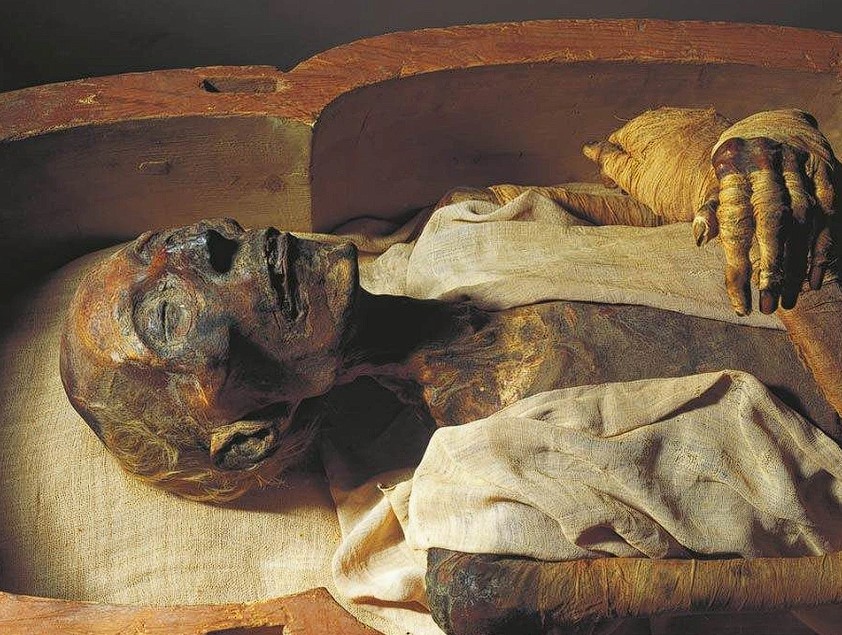The mummy of Thuya, a prominent figure in Ancient Egypt, offers an invaluable insight into the royal family and their complex dynastic relationships. As the mother of Queen Tiye and grandmother of Akhenaten, Thuya played a crucial role in shaping the 18th Dynasty. The discovery of her mummy has provided new perspectives on her life and legacy, cementing her importance in Egyptian history. Follow archeology.dulichvn.net to learn more about mysterious artifacts.

Thuya’s Royal Lineage and Family Connections
Mother of Queen Tiye and Grandmother of Akhenaten
Thuya’s profound impact on Egyptian history is undeniably linked to her direct connection to some of the most renowned figures of the Ancient Egyptian world. As the mother of Queen Tiye, Thuya was the matriarch of a powerful royal line. Queen Tiye herself was a prominent figure, known for her political influence and her role as the wife of Amenhotep III, one of Egypt’s most successful pharaohs.
Thuya’s legacy extended to her grandson, Akhenaten, a pharaoh known for his radical religious reforms, including the worship of the sun god Aten. Moreover, through her great-grandson, the famous Tutankhamun, Thuya’s lineage continues to play a significant role in shaping the history of ancient Egypt. These generations of powerful figures cement Thuya’s place at the heart of one of Egypt’s most influential royal dynasties.
Possible Descendant of Queen Ahmose-Nefertari
Another fascinating aspect of Thuya’s ancestry is the possibility that she was a descendant of Queen Ahmose-Nefertari, one of the most revered queens of the early 18th Dynasty. Queen Ahmose-Nefertari played a key role in Egypt’s liberation from the Hyksos invaders and was highly venerated by later generations. If Thuya’s connection to this remarkable queen is confirmed, it would further elevate her status and heritage, linking her to one of the most powerful and respected families in Egyptian history. Such a lineage would reinforce Thuya’s royal standing, providing even greater insight into the strength and influence of the royal family during her time.
Thuya’s Titles and Status
Throughout her life, Thuya was bestowed with several prestigious titles that reflected both her royal standing and her religious influence. As “Singer of Hathor,” Thuya was deeply connected to one of Egypt’s most important deities, Hathor, the goddess of music, love, and motherhood. Hathor’s worship was central to Egyptian culture, and Thuya’s association with her suggests that she may have held a prominent role in religious ceremonies.
Additionally, Thuya was titled “Chief of the Animers,” a role that indicates she oversaw religious activities dedicated to the gods Amun and Min. Both of these deities were central to Egypt’s religious life, with Amun being one of the most powerful gods of the Egyptian pantheon and Min representing fertility and male potency. These titles suggest that Thuya was not only a royal matriarch but also a key religious figure, blending her royal responsibilities with her spiritual duties, further reinforcing her importance in Egyptian society.

The Mummy of Thuya: A Remarkable Discovery
The Remarkable Preservation of Thuya’s Mummy
The discovery of Thuya’s mummy offers a rare and invaluable opportunity to explore the life of a royal figure from the 18th Dynasty, a period of immense cultural and political significance in ancient Egypt. The careful preservation of her body showcases the advanced embalming techniques employed during her time.
Archaeologists have noted the meticulous procedures that were used to preserve Thuya’s remains, providing a remarkable insight into the high standards of mummification that would later be used on notable pharaohs such as Tutankhamun. These methods not only highlight the Egyptians’ expertise in preserving the dead for the afterlife but also serve as a testament to the importance of maintaining the physical body in a state suitable for eternal life.
Artifacts and Burial Goods: A Glimpse into Royal Life
Accompanying Thuya’s mummy were several significant artifacts, which provide essential insights into the material culture of the period. These objects, ranging from personal items to burial goods, offer a glimpse into the lifestyle, beliefs, and customs of the Egyptian elite.
The presence of lavish burial items is a clear indication of the immense wealth and power that Thuya’s family possessed, emphasizing their influence within both religious and royal circles. Among the artifacts were finely crafted jewelry, pottery, and inscriptions that not only illuminate the daily life of the time but also reveal Thuya’s prominent role in royal and religious affairs. These discoveries allow archaeologists to piece together the social and cultural context of the 18th Dynasty.
The Significance of the Discovery Location: Valley of the Kings
Thuya’s mummy was uncovered in the Valley of the Kings, a site renowned for housing the tombs of Egypt’s most illustrious rulers and royals. The Valley’s rich archaeological context adds to the significance of this discovery, as it underscores Thuya’s high rank within the Egyptian royal family.
This sacred burial ground, reserved for pharaohs and their closest relatives, provides further evidence of Thuya’s esteemed position in society. As one of Egypt’s most important archaeological sites, the Valley of the Kings continues to reveal the lives, customs, and legacies of Egypt’s greatest rulers, offering invaluable insights into the culture of ancient Egypt. Thuya’s burial there solidifies her role in the royal lineage and highlights the deep respect and reverence afforded to her during her lifetime and in the afterlife.

Thuya’s Cultural and Religious Influence
Thuya’s Role as a “Singer of Hathor”
One of the most significant titles held by Thuya was “Singer of Hathor,” a position that tied her directly to the spiritual and religious life of Ancient Egypt. Hathor, revered as the goddess of love, music, dance, and motherhood, occupied a central place in Egyptian religion. She was considered a divine nurturer and protector, associated with joy and fertility.
Thuya’s title as “Singer of Hathor” suggests that she was actively involved in religious rituals and ceremonies dedicated to this powerful deity. Music and song were integral to Egyptian worship, serving as a conduit to communicate with the gods. As a “Singer of Hathor,” Thuya would have participated in these sacred rituals, using her musical talents to invoke the goddess’s blessings and create a sacred atmosphere. This role not only connects Thuya to the divine but also reflects the importance of music and religious expression in the daily life of the ancient Egyptians.
Chief of the Animers of Amun and Min
Another notable title of Thuya was “Chief of the Animers,” which indicates her leadership over the priests and religious activities dedicated to two of Egypt’s most influential gods: Amun and Min. Amun, the supreme god of Thebes and the ruler of the Egyptian pantheon, was often associated with creation, power, and the sun, while Min was revered as the god of fertility and male virility.
The title “Chief of the Animers” suggests that Thuya had a prominent role in managing the priests and overseeing the rituals performed in honor of these gods. In this capacity, Thuya would have exerted significant influence within the religious community, ensuring the proper conduct of worship and maintaining the balance between the divine and the mortal world. Her leadership in these key religious spheres further cemented her role as a powerful figure in Ancient Egyptian society.
The Religious Significance of Thuya’s Titles
Thuya’s religious titles reflect her deep involvement in the spiritual practices of her time, highlighting the inseparable connection between royalty and religion in Ancient Egypt. As the “Singer of Hathor” and “Chief of the Animers,” Thuya was not only a prominent royal figure but also a significant religious leader. Her influence over the priesthoods of Amun and Min would have given her a unique position of power, extending her reach beyond the royal court and into the temples and religious communities.
The duties associated with these roles likely allowed her to shape the religious landscape of her era, ensuring the proper worship of Egypt’s most revered deities. Thuya’s religious titles therefore not only reflect her personal devotion but also underscore her integral role in maintaining the harmony between the spiritual and political realms of Ancient Egypt.

Thuya’s Legacy in Ancient Egypt
Influence on Queen Tiye and Akhenaten
Thuya’s profound legacy is most evident in the lives and actions of her direct descendants, especially her daughter, Queen Tiye, and her grandson, Akhenaten. Queen Tiye was a powerful and influential queen consort during the reign of her husband, Amenhotep III. Her significant political and diplomatic involvement helped to shape Egypt’s domestic and foreign policies.
Tiye’s influence extended further to her son, Akhenaten, who is known for his radical religious reforms, most notably the establishment of Atenism as the state religion. These sweeping changes had a transformative effect on Egyptian society, moving away from the traditional polytheistic worship of gods like Amun to a more monotheistic focus on the sun god Aten. Thuya’s legacy, therefore, is intricately woven into the reigns of both her daughter and grandson, whose decisions continue to impact the course of Egyptian history.
Thuya’s Role in Egypt’s Royal Dynasty
As a central figure in the royal family, Thuya’s position placed her at the heart of the significant political, cultural, and religious developments during the 18th Dynasty. Her family, with its royal connections and influential members, played a pivotal role in shaping Egypt’s future during a period of great change. Her descendants, including Queen Tiye and Akhenaten, were integral to the dynasty’s political machinations and religious transformations.
Thuya herself, through her royal connections and titles, contributed to the broader cultural and religious movements that defined the 18th Dynasty. Her influence in these areas underscores her importance as a figure who helped maintain and enhance the power and prestige of Egypt’s royal lineage.
A Lasting Impact on Egyptian History
While Thuya herself may not have been as publicly renowned as her descendants, her influence on the royal family and the course of Egyptian history is undeniable. The discovery of her mummy and the associated artifacts provides critical insight into the religious and political dynamics of the time.
The titles and roles she held reflect her involvement in both the political and spiritual life of Egypt, marking her as a figure of substantial importance. Her legacy persists, not only through the powerful actions of her children and grandchildren but also through the artifacts and monuments that continue to offer a glimpse into the inner workings of the 18th Dynasty. Thuya’s life and legacy are integral to understanding the complex and often transformative nature of Ancient Egyptian royalty.
See more: The Fontaines de la Concorde: A Masterpiece of Parisian Elegance
Conclusion
Thuya’s mummy and the discoveries surrounding it reveal the profound impact she had on Ancient Egypt. As the mother of Queen Tiye, grandmother of Akhenaten, and great-grandmother of Tutankhamun, Thuya was a central figure in the royal family. Her roles in religious and royal affairs highlight her influence, and her legacy continues to inform our understanding of Ancient Egypt’s dynastic and religious history.


CÁC TIN KHÁC
Mary Walton: The Forgotten Inventor Who Helped Clean Up America’s Cities
Tomb of Queen Nefertari in the Valley of the Queens, Egypt
Discover the Hypostyle Hall of the Temple of Hathor at Dendera
Venus de Losange: Unveiling the Mystery of a 20,000-Year-Old Paleolithic Icon